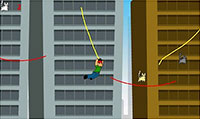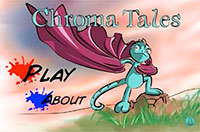Half of Game Design Finalists from UH
 Students in the University of Houston Interactive Game Development Program continue to excel at Microsoft’s Imagine Cup U.S. event, the world’s premier student technology competition. Students in the University of Houston Interactive Game Development Program continue to excel at Microsoft’s Imagine Cup U.S. event, the world’s premier student technology competition.
Two teams from UH were among 10 finalists chosen from thousands of America’s brightest young computer science students to reach the final round of the 11th Annual Imagine Cup U.S. Finals. The event showcased teams from the three major competition categories – Games, Innovation and World Citizenship.
UH Gaming Consistently Recognized
For the fourth consecutive year, UH was the only school to have more than one team selected in the gaming category. This category challenges students with creating a new game, changing a current genre or developing a new visual style of game using Microsoft platforms such as Windows PC, Windows Phone, Xbox, Indie Games or Kinect SDK. Both UH teams created new Windows Phone games. Only four gaming teams made it to the 2013 U.S. Finals.
“In addition to being the only institution to have two teams in the final 10, UH had an impressive showing among the top 25 U.S. teams,” said Chang Yun, interactive game development instructor and research assistant professor in the Department of Computer Science. “In all, six UH gaming teams were recognized, representing 67 percent of that category. This shows the strength of UH’s gaming program in both quality and quantity.”
As top 10 finalists, the UH teams presented at the U.S. Finals Demo Day, May 13, at Microsoft’s Silicon Valley Campus in Mountain View, Calif. Demo Day activities included each team’s live presentation, feedback from the judges, an opportunity for final changes, and submission of the final prototype for hands-on evaluation by the judges. Judges evaluated the game entries using four criteria – fun, execution, innovation and business viability.
The Demo Day audience included investors, entrepreneurs and technology-industry professionals.
The College of Natural Sciences and Mathematics hosted a reception May 15 at the Hilton Santa Clara celebrating the UH teams’ achievements and bringing together NSM alumni living in California. Alumni and donors got a chance to demo the games and meet the students on the two finalist teams.
Team Skyline Studios – Rescuing Cats
 Team Skyline Studios developed “Zipline Hero,” a puzzle-action platform game where the player uses the touch screen input to rescue animals. In the game, the player manipulates the world around the Zipline Hero to rescue cats and bring them to a pet shop. Team Skyline Studios developed “Zipline Hero,” a puzzle-action platform game where the player uses the touch screen input to rescue animals. In the game, the player manipulates the world around the Zipline Hero to rescue cats and bring them to a pet shop.
“We wanted to do a phone game but didn’t want to copy one of the games already out there. We wanted to make something new and exciting,” said Justin Wells, the team leader of Skyline Studios.
Wells and his fellow teammates, Sean Howard and Anthony White, are computer science majors at UH and wanted the game’s design to take full advantage of modern technology. The player uses touch controls and the phone’s accelerometer to guide the character and cut ropes, using timing and accuracy to complete physics-based puzzles in the world. The end goal is to bring all the cats to safety and find out who is stealing them.
“We’ve learned a lot about programming at UH, and the Imagine Cup gave us our chance to show what we’re capable of doing with that knowledge,” Wells said. “Going to the competition was exciting, but I think proving to ourselves how much we can accomplish has been the biggest reward of all. It’s really amazing what a small group of people can create when we push ourselves.”
Team Lost Spectrum – Playing Through the Colors
 Lost Spectrum, a group of self-described entrepreneurs, designers and mad scientists, developed “Chroma Tales,” a fast-paced 2D action game where each player’s mission is to restore color to the world. Lost Spectrum, a group of self-described entrepreneurs, designers and mad scientists, developed “Chroma Tales,” a fast-paced 2D action game where each player’s mission is to restore color to the world.
Led by Zach Nguyen, the four members wanted to create a game they found fun that would work well on a mobile phone. Chroma Tales’ game architecture involves several small, quick levels. The team felt this design would allow them to easily create new levels and release expansion packs of levels with different themes.
“We decided it would be cool to have the game change colors as you play through the levels. In testing, this helped the player feel a sense of accomplishment as he could watch the game change according to how well he was doing,” Nguyen said. “It also gave the game a sense of tempo. Without changing anything but the colors, the player felt the game get more intense, and the tension would build without the difficulty increasing. Adding to the intensity is that our game is a set of fast-paced microgames, with each level lasting approximately five seconds.”
Nguyen and teammate James Richardson are computer science majors at UH, and Lauren Truong is the artist. Paul Nesbitt, a computer science major at the University of Texas, joined the team after their first semester of working on the project. He is a friend of the group’s from high school.
Legacy of Success
UH’s computer science department has a legacy of success at the U.S. Imagine Cup. Last year, three teams competed in the finals, taking third place in mobile game design and fourth place in Windows/Xbox game design. In 2011, four teams made it, bringing home first and second place in mobile and third place in Windows/Xbox, and two game design teams brought home second and third place in 2010.
- Kathy Major, College of Natural Sciences and Mathematics, and Lisa Merkl, University Communication |

